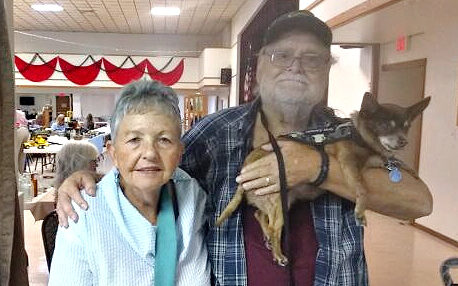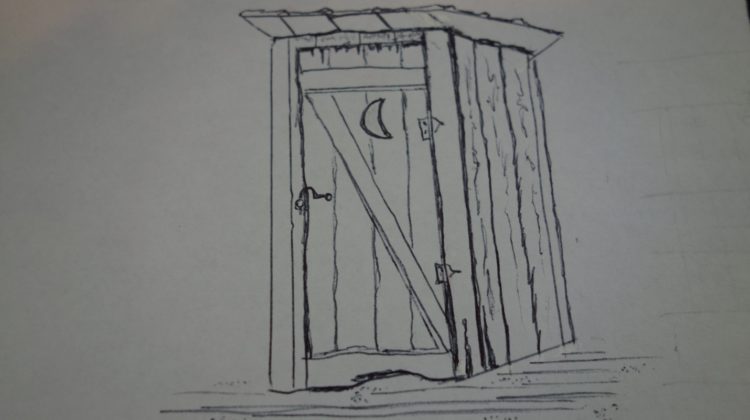
Sketch by Lynn G. Howell
The Low-Down on Privy Marbles
Full disclosure: we have never dug a privy![1] Never had the opportunity and we have learned recently that you have to be either young and strong or older and in good physical shape to successfully dig. Some privy digs are so deep that a ladder is needed just to reach the bottom!
But we have both used one. Larry had a childhood friend whose home had no running water. Their outhouse was between the barn and the house and far away from the well which was on the back porch. We have heard of families having two outhouses—one nearer the house and a second one near the barn since many members of the family spent most of their time in or near the barn. However, we never saw a home place with two privies. At any rate: “ The sun too penetrates into privies, but is not polluted by them.” Diogenes
Privy, Outhouse, Jake, Latrine, or Loo?
In this post we will call the little house out back a privy. This word has been used since c 1200. An online dictionary tells us that privy is from the Latin privatus (private) by way of Middle English prive and Old French privé, privee, literally a “private place”. [2]
Frankly, having lived overseas for several years in primarily British expat communities, we also like the word loo. But loo is not actually British. The word is French, but we are staying far away from the “gardyloo!” in this post. And Outhouse is, after all, a proud family name.
Do Privies Have Gender?
Sue Bowman has given us the well-written “Pondering the Privy: A History of Outhouses”.[3] We list just a few of the points made by Bowman along with our commentary on some of the topics:
Many privies had openings for ventilation. Bowman tells us that the crescent moon, like the one the door of our feature sketch, is the symbol for the Roman Moon Goddess, Luna. This indicates that this is the ladies’ privy. This is an interesting factoid, but “back in the day” we remember that a household generally had one privy for everyone.
- On the same note: a circle or star was the symbol of the sun and the Greeks’ male sun god Apollo. Historians tell us that many more female than male outhouses have survived. This must be true, because we have never even seen a male outhouse! Still, don’t you think that far more privies were built with a moon rather than with a circle or star?
And Furthermore…
- Most privies were made of wood and although we have heard of brick outhouses we can’t remember ever seeing one.
- Pit privies are the most common country privy type, and it is these backfilled pits which are generally easy to spot on a vacant lot where a home once stood. Old pit privies are the ones most often dug today. However, some privies did and do have concrete vaults rather than dirt pits.[4]
- Bowman doesn’t mention this type privy but we used to walk in an old mill town in Northwest Georgia which used the pail or bucket privy design. We have since learned that this was a common privy plan in many cities all across America.
- In the Georgia mill town there was a small house behind each home where the family could store yard tools, old furniture, and so on. And inside this house was a privy. It looked very much like a pit privy, except that the outside of the bottom had a latch and hinge. Each morning a worker came through the mill village in his “honey wagon” and emptied the bucket from inside each privy. He opened the small door on the bottom of each privy from the outside!
- Where did he dump the wagon? We don’t know but Silver Creek, which is beautiful, runs through the village. And yes, we found a marble at the bottom of the creek!
- Typical pit privies sat over a hole three to six feet deep. The little house was about a three to four foot rectangle and it was about seven feet tall.
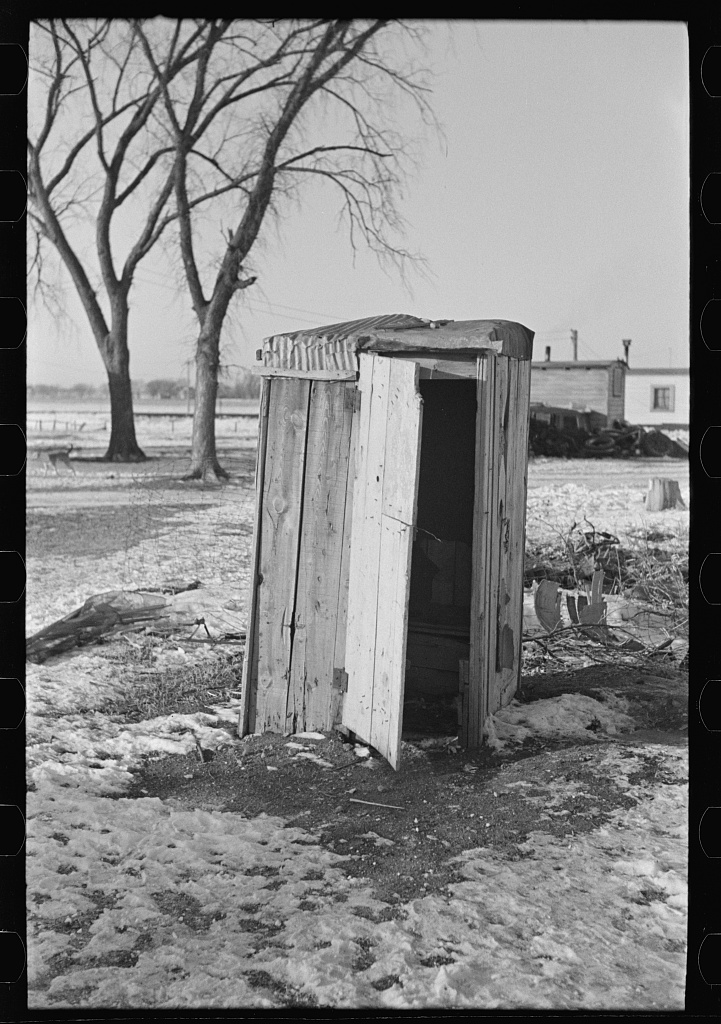
Outhouse in “Shantytown,” Spencer, Iowa This is an example of a pit privy.[5]
Beau-nasty!
The privy was one of life’s necessities, and as you can see in this photograph, they were not always the most inviting places on the homestead. This little house was a rural privy; there were differences between city and rural privies. Check the door on this privy: there is no vent at all. Genderless! It was doubtless a good idea to just leave the door open even when in use! We don’t see a hook or lock on this one. Do you?
Let’s Get Down to Business . . .
Bowman doesn’t mention this but we read elsewhere that two people could dig the pit and build a privy in about four hours. Believe it or not there were pit privies with no cover at all; just the bench, holes, and the pit!
And, finally, according to Bowman, toilet paper was not commonly used until the 1920s, and it was first sold in packs of sheets rather than on rolls.[6]
Generally, the bench in the privy had two or three holes, and depending on the family using it, the holes were often of different sizes. Some holes were for the adults and there were smaller ones for the children. Take one more look at our featured sketch at the top of this Post. Notice that privies used by a family generally did have a hook. Children did fall into the pit through the hole! Bowman tells us that some died.
Miscreants
Over the years all sorts of crimes happened in the privy both in the city and country. And, over the long years that the outdoor privy was in use, all sorts of odd and mysterious things happened in that little house as well. The Marble Hill Press (Missouri 1898) tells us that someone found an expensive and beautiful marble head in a privy! It was pulled out and given to the British Museum.
In 1883 The Cheyenne Daily Leader reported that a woman attempted to hang herself in the outhouse after she butchered her three children. People have taken refuge from storms in a privy, and in one case there were several people who crowded inside all at the same time!
We know of a more recent case in which a man dropped his phone down the hole, climbed down to fetch it, got stuck and couldn’t get back out! And the privy could be used as a starting place for escape tunnels dug by Confederate prisoners on Johnson’s Island during the Civil War.[7]
And finally, mostly in the city, the privy was often a litigious hot potato. People in one home would build the smelly outhouse as far from their home as possible. This sometimes meant that it was much too close to the property line and to the house next door. Noxious fumes sometimes wafted over the dining room of the neighbor’s house. The privy was a common source of law suits in the 1800s.
Privies are Archaeologists’ Gold Mine[8]
This is from the abstract of an archaeological study: “To the archaeologist, the refuse deposits found on domestic sites are a source of information about diet, health, and consumer behavior.”[9]
We are confident that coins were accidentally dropped down the hole in the past. And since the privy was also the house refuse dump, all sorts of other “goodies” went down the hole as well.
While very few brave souls were ever willing to venture into the hole to retrieve anything “back in the day”, today it is perfectly fine and scent-free. Really. We think of it as similar to the soil in a Native American midden. We are told by experienced diggers that over the years water has percolated through the soil and leached out bacteria leaving only “clean” soil and artifacts. Of course, dust may be a problem, but, we are told, you won’t catch some odd bug from the soil.
What Can You Find Down There?
Diggers find an almost endless variety and color of antique bottles both mouth blown and molded. Medicine bottles are very popular finds, because so much can be learned by their color and any embossing on the glass. Visit our post Far Flung in Wimauma to learn about some of our surface finds from historical neighborhoods.
Ink wells are found along with bones, seeds, pollen, all sorts of glass, metal, ceramics, and even wooden artifacts. Archaeologists digging an old boarding house privy in Buffalo, New York, found chamber pots, plates, saucers, teapots, and lots of smoking pipes (https://www.jstor.org). The chamber pots are not a surprise: they were used in the home, in the bedroom, for example, overnight and then dumped in the pit in the morning. Oops, slippery!
So, old privies hold both lost treasure and refuse, and both can tell a lot about the lives and times of the people who lived nearby. Did the family drink beer, whiskey, or champagne, is just one example. Did they have meat to eat? If so, what kinds? Could they afford to buy medicine? Were they well-to-do or poor? Did the children have toys like marbles, tops, dolls?
Chasing History
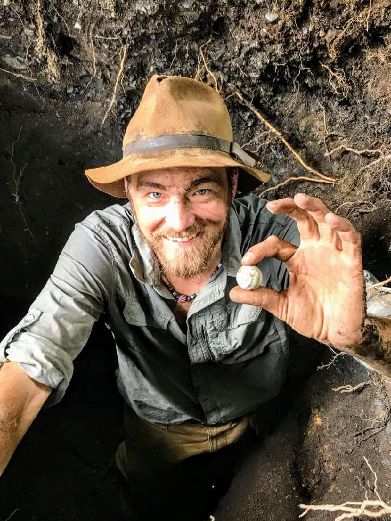
“Chasing History,” Chase Pipes, holding one of the marbles that he found
while digging an old privy in Knoxville, TN! [10]
We know from field experience and study that neither RPAs nor academic archaeologists could ever possibly have the time, inclination, and the funding and support needed to dig even a small fraction of the historical privies scattered all across America. For one thing, no one has any idea how many there were. Remember, families often lived on their land for generations and their outhouse may have been moved many times as each one became full. Also, diggers have no idea where these old pits are.
We are not talking about privies located on state and federal historical sites, old forts, or battlefields. Thousands of home places all across America left privies full of treasure, but often the homes are long gone and their sites have no significant historical importance. Why would archaeologists be at all interested in digging hundreds of such privies?
Smoky Mountain Relic Room: Cooperation in Action!
If you have never visited The Smoky Mountain Relic room in Sevierville, Tennessee, then you really must! And if you have visited, then we know that you are anxious to go back. You can literally spend the day there. The “room” is one “small corner” in the 110,000 square foot Smoky Mountain Knife Works and it bills itself as “home to the largest and most diverse range of historical artifacts for sale in North America.”
Chase Pipes is shown with a grin and a marble from a privy dig in the photograph above. He wrote about the 2021 privy dig in Knoxville, Tennessee.[11] He notes that when the old privy was in use “…while fumbling around in the dark, folks would accidentally lose things like lanterns, medicine bottles and watches. And don’t forget that kids will be kids. Young’uns might throw things like marbles, little sister’s dolls or mom’s expensive perfume bottles down the hole.” As we have noted, “Once those objects passed that lid, no one was going down to fetch them.”
At the Knoxville dig, Pipes and his team discovered all kinds of treasure including thousands “…of perfectly preserved heirloom tomato seeds from the 1890s that can actually be replanted today to grow new tomato plants!”
Pipes continues that “we believe our access to these 130-year-old seeds could be an exciting endeavor for any university. We are currently putting together a team of professional outhouse diggers to collect and record as many seeds as possible…We are currently in search of a university institution or college student that would want to pursue this scientifically.”
Show and Tell
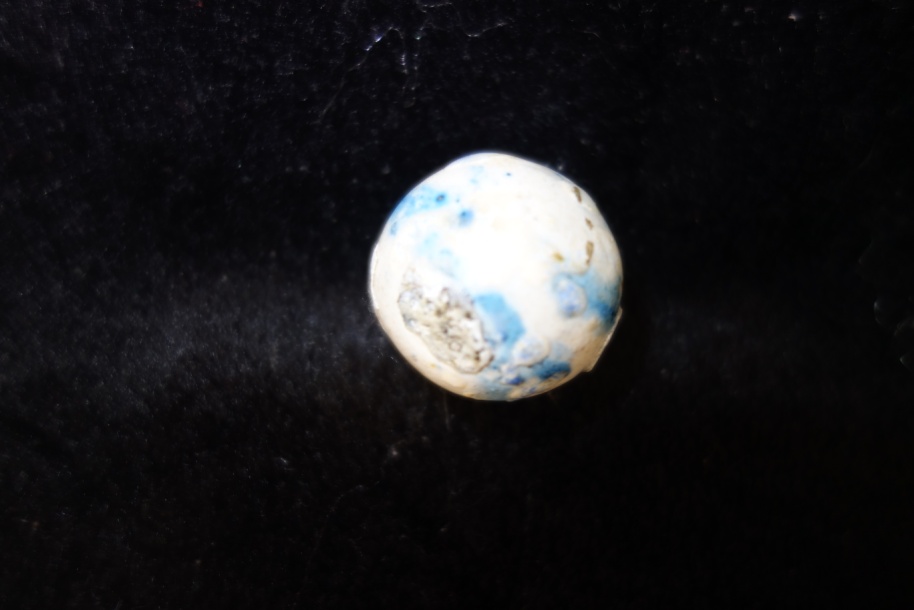
While we have never dug a privy, we have bought a few privy-dug marbles. They are not easy to find, but when you do find some they are usually just a very few dollars each.
While in Waldo, Florida in 2012 we bought our first privy marble. The photograph above actually catches its better side! It has to be one of the ugliest marbles in our collection. It is 1” and heavily glazed and slipped. It has a white base with blue streaks on the surface. Unlike Benningtons, this one has gobs of excess slip in hard mounds all over its surface.
There are blue streaks across the top of the marble so it is not a variegated jasper: the blue is on the surface rather than in the makeup of the marble. There are photographs very similar to this marble in Block’s Marbles Beyond Glass pages 102 – 103.
Could This Really Be “China”?
This marble dates to the Late Period of Chinas (1870 – 1890). By the 1890s, china marbles were quickly made and they were often crude like this one. Workers decided that just a line or two of color would be enough. We won’t even ask about quality control since there obviously was none.
Still, the old marble has a story. The dealer said that he was cleaning up the family farmstead near Augusta, Georgia. The farm was built sometime in the Civil War era. This old marble was found in the farm privy. Augusta, in Richmond County, is a very old and very “handsome” city. The population was 13,400 in 1890,[12] about when this old marble was lost.
New Orleans Privy
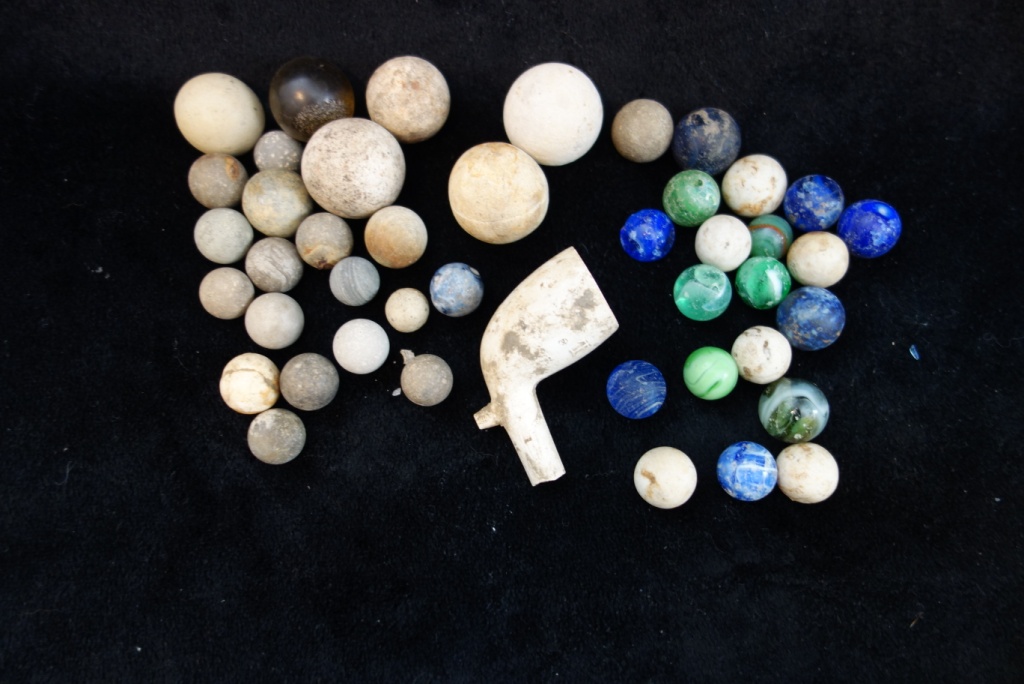
It was ten years before we saw another privy marble! At the 5th Annual Mississippi Gulf Coast Antique Bottle Show in Biloxi we met a gentleman who was in a hurry packing up to move to a show in Jackson, Mississippi. He was not interested in taking these marbles along with him and he told us that they were dug in a Privy in New Orleans.
We got them for almost nothing, but we could not get much information about them. This is not surprising. Diggers often are very reluctant to share specific information about where they dig for any number of reasons. And as far as we know the seller may have bought them from the digger and then passed them along.
The marbles and the pipe bowl shown in the photograph above were in a plastic bag together. We have no idea why there was such an odd group of artifacts in the same bag. Obviously with stone, clay, and then glass marbles we have a wide and open-ended range of dates. It is possible to dig such a range of artifacts from one privy.
A Clay Pipe Bowl
We have studied how to date pipe stems using a drill bit in a university archaeology lab, but we have never collected clay pipe bowls or stems so we never developed any skill at it.[13] But, we have learned that the slope of the bowl and the spur, both of which are present on this bowl, are important tools in dating. The maker’s mark “T.D.” and the provenience provided by the seller helped us determine that this pipe bowl dates to the mid or late 1800s. McDougalls of Glasglow, Scotland, was still making “TD” pipes in 1900.[14]
New Orleans Privy Marbles
This group has the most stone marbles we have ever seen at one time. And there are all kinds of stone! There are 26 stone marbles in all include one Native American. This one is egg-shaped and about 1⅛” X 1¼” end to end.
As for the glass marbles, there is little that we can say about them other than they are completely worn out. We don’t think that the wear on these old slags is from oxidization or any other natural processes. It appears to simply be use. We can no more date them correctly than we can date the handmade stone marbles.
We know for a fact, however, that not all glass privy marbles are in such poor condition. Remember, little boys were notorious for throwing their rivals marbles down the hole! And at least some of these were mint!
Backfill
Well, we have told you all about privies and privy marbles and we hope that we have awakened some spark of interest. If you have tubs of privy marbles—Congratulations! We would love to hear from you about any of your privy digging adventures that you care to share. Any and all tips and tricks would be greatly appreciated.
Got Privy Fever?
If you would like to privy dig but don’t know where to start we have given you some references to help you out. Minimum investment in tools and equipment is required. Make some ‘phone calls; email some sources; and visit a bottle show nearby if possible.
But, it is important to remember to ask for permission before digging. Check out this headline from The New York Times in 2001: “Threat to Archaeology: The Privy Digger.”[15] The first paragraph of the story reports on a weekend digger in Lincoln, Nebraska. He was “hauled into court” and charged with “trespass, criminal mischief and theft.” He was, according to The Times, “looking for bottles, dishes and, as one privy digger put it, lots of ‘real cool stuff.’”
One additional point that both professional (RPA)[16] and academic archaeologists make is that by digging into an old privy the site is thereby changed.
If you do see some privy marbles in a flea market or antique store to try and get as much information about them as you can. Remember, the seller may be cagey about the marbles or other artifacts found in a privy. Don’t push too hard for details.
And, above all, happy hunting!
Comment:
Austin Dalton, Smoky Mountain Relic Room, THERELICROOM.COM
“Everything looks absolutely incredible and we’re so honored to be a part of it!”

- There are an almost limitless number of online videos, articles, and books on the “how to” of privy digging. Bottle and glass clubs can provide a wealth of information, and sometimes even field trips. But remember, “Privy digging is rough stuff”. You might want to check Rick Werner, “Digging for Old Glass.” Bottles and Extras. July-August 2012, pps. 29 -35. Federation of Historic Bottle Collectors: https://www.fphbc.org 2/28/2023 ↑
- https://www.etymonline.com/word/privy 2/23/2023 ↑
- Lancaster Farming. Bowman, Sue, “Pondering the Privy: A History of Outhouses.” 15 November 2015; Updated 1 December 2022 @ https://www.lancasterfarming.com/country-life/antiques-and-history/pondering-the-privy-a-history-of-outhouses/article_3f416eae-d0df-5d7f-9e70-3fcfb72a110a.html/ 2/27/2023 ↑
- See U.S. Public Health Service, “The Sanitary Privy,” Supplement No. 108 to the Public Health Reports (Washington, DC: Government Printing Office, 1933). and Ronald S. Barlow, The Vanishing American Outhouse: Privy Plans, Photographs, Poems, and Folklore (New York: Viking Penguin, 2000). ↑
- United States Resettlement Administration, Lee, R., photographer. (1936) Outhouse in “Shantytown,” Spencer, Iowa. United States Iowa Spencer, 1936. Dec. [Photograph] Retrieved from the Library of Congress, https://www.loc.gov/item/2017735157/. ↑
- Just as there are histories of privies, there is also a history of toilet paper. Ponti, Crystal. “All the Ways We’ve Wiped: The History of Toilet Paper and What Came Before.” 15 April 2020. https://www.history.com/news/toilet-paper-hygiene-ancient-rome-china (2/27/2023) Ponti tells us: Among tools people used in the past were moss, sponge on a stick, ceramic pieces and bamboo ‘spatulas.’ ↑
- Bush, David R. :”Interpreting the Latrines of the Johnson’s Island Civil War Military Prison. Historical Archaeology “View from the Outhouse: What we can learn from the Excavation of Privies.34.1 (2000), pps 62 – 78. https://www.jstor.org/stable/25616772?mag=privies-vaults-of-the-past ↑
- Wills, Matthew. “Privies: Vaults of the Past.” 3 April 2015. https://daily.jstor.org/daily-author/matthew-wills/ ↑
- Crane, Brian D. “Filth, Garbage, and Rubbish: Refuse Disposal, Sanitary Reform, and Nineteenth-Century Yard Deposits in Washington, D.C.” Historical Archaeology, 34.1 (2000), pps. 20 -38. http://jstot.org/ 2/27/2023 ↑
- Thank you, Austin Dalton, Smoky Mountain Relic Room THERELICROOM.COM . Also check out Chasing History: History of Marbles – Collecting & Hunting Link – Chasing History: History of Marbles—Collecting & Hunting – YouTube. For other great videos press the “Chasing History” button on the Relic Room’s webpage. ↑
- Pipes, Chase. “Relic Room team digs up artifacts from centuries-old outhouse pits.” 3 November 2021. Knoxnews. @ https://www.knoxnews.com/story/sponsor-story/smoky-mountain-relic-room/2021/11/03/relic-room-team-digs-up-artifacts-centuries-old-outhouse-pits/6240045001/ 2/28/2023 ↑
- https://greenerpasture.com/Places/ShowNews/70755 3/2/2023 ↑
- You might want to read Deetz, James. In Small Things Forgotten. New York: DoubleDay. 1996. page 28. ↑
- Walker, Ian C. “TD Pipes”, Bulletin of Archaeological Society of Virginia, Vol. 20 No.4, 1966. ↑
- You can read the story online @ https://www.nytimes.com/2001/07/28/arts/threat-to-archaeology-the-privy-diggers.html 2/27/2023 ↑
You might want to check out The Register of Professional Archaeologists website @ https://rpanet.org/
Comments:
“Everything looks absolutely incredible and we’re so honored to be a part of it!” by email. Austin Dalton, Smoky Mountain Relic Room, THERELICROOM.COM

